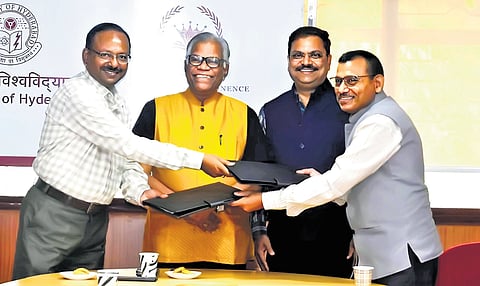

HYDERABAD : The latest buzzword in sustainability — green steel — has evoked optimism and scepticism globally. In India too, the steel industry has been made a stakeholder in the National Green Hydrogen Mission for green hydrogen production and usage.
Closer home, the School of Engineering Sciences and Technology (SEST) at the University of Hyderabad (UoH) recently inked a Memorandum of Understanding (MoU) with the National Mineral Development Corporation (NMDC) in an encouraging step towards the advancement of sustainable practices in the mining, iron and steel manufacturing industries.
Speaking to TNIE, Prof Jaiprakash Gautam, Dean of SEST, says that the MoU seeks to take the collaboration between the two institutions to a “higher” level. The MoU, valid for five years, will focus on collaborative research, student and faculty exchange in the fields of technology for manufacturing green steel, technology for the direct utilisation of low-grade iron ore fines and exploring innovative methods of mining waste utilisation.
Green steel, the name given to steel produced through processes that do not emit carbon dioxide, entails using hydrogen as the ‘reducing agent’ that pulls oxygen away from the iron dioxide, instead of carbon.
As per a release from the Press Information Bureau (PIB), the carbon emissions from the iron and steel sector as reported by the Ministry of Environment, Forest and Climate Change (MoEFCC) in 2016 was 135.420 million tonnes.
Obstacle of green hydrogen
According to Prof Gautam, reports of green steel production in India being “unlikely” as much of Indian iron ore is low-grade are “incorrect”. He says, “We produce the best iron ore in the world. The technology to produce green hydrogen is the challenge before us.”
Dr Vibhuti Roshan from the Research and Development (R&D) Centre of the NMDC agrees. “It is not economical right now as the cost of hydrogen is very high. Once the technology is devised, green steel definitely has a future in India,” he says.
He adds that NMDC’s demonstrations in the field are currently in the pilot stage.
Emphasising the importance of sustainable innovations in the mining industry as the processes of the industry guzzle energy and are harmful to the environment, Prof Gautam says that activities under the partnership will explore alternate methods to convert mining waste into value products.
Prof Gautam is also looking forward to the collaboration between industry and academia. He says, “Through such collaborations, the students get to see first-hand the application of the theories they learn. Their entire visualisation will change.”
Dr Roshan says, “While academia engages with basic research, we do applied research. The combination of the two will help.”
‘India produces best iron ore in the world’
According to Prof Gautam, reports of green steel production in India being “unlikely” as much of Indian iron ore is low-grade are “incorrect”. He says, “We produce the best iron ore in the world. The technology to produce green hydrogen is the challenge before us.”